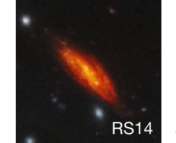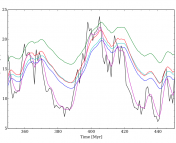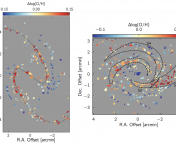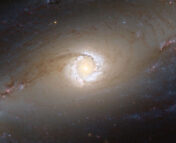Title: PHANGS-JWST First Results: A combined HST and JWST analysis of the nuclear star cluster in NGC 628
Authors: Nils Hoyer, Francesca Pinna, Albrecht W. H. Kamlah, Francisco Nogueras-Lara, Ania Feldmeier-Krause, Nadine Neumayer, Mattia C. Sormani, Médéric Boquien, Eric Emsellem, Anil C. Seth, Ralf S. Klessen, Thomas G. Williams, Eva Schinnerer, Ashley T. Barnes, Adam K. Leroy, Silvia Bonoli, J. M. Diederik Kruijssen, Justus Neumann, Patricia Sánchez-Blázquez, Daniel A. Dale, Elizabeth J. Watkins, David A. Thilker, Erik Rosolowsky, Frank Bigiel, Kathryn Grasha, Oleg V. Egorov, Daizhong Liu, Karin M. Sandstrom, Kristen L. Larson, Guillermo A. Blanc, and Hamid Hassani
First Author’s Institution: Donostia International Physics Center, Spain
Status: accepted for publication in ApJL [open access]
What lies at the center of a spiral galaxy? Turns out it’s not so easy to tell! Galaxy centers are messy, crowded, brilliant places where astronomers have to confront heavily obscured stellar populations, extremely dense and chaotic clouds of dust and gas, and the complexities of powerful gravitational and magnetic forces. Many spiral galaxies, like the subject of today’s paper (NGC 628, shown in Figure 1), have star-forming rings around their centers and a mysterious empty gap in the innermost few tens of parsecs. Well, not entirely empty – it’s full of stars! In fact, if we lived on a planet near the Milky Way’s Galactic Center, we would be able to see more than a million times as many stars in our night sky.
The nuclei of many galaxies are home to Nuclear Star Clusters. These clusters are made up of hundreds of millions, even billions of stars, contained within a few to tens of parsecs (relatively tiny, given the immense number of stars). While the origin and the nature of these high-density star clusters remain largely mysterious, we can study them to learn a lot about the star formation properties and histories of their host galaxies. Our own Galactic Center’s nuclear star cluster has been a great observational challenge due to the pesky fact that we’re embedded in the Galaxy and have to stare through most of the disk to figure out what’s going on in there. Other galaxy centers are hard to observe because, well, they’re very far away! Resolving the details of the nuclear stellar populations of galaxies would require, say, an immensely powerful modern infrared space telescope…
Today’s authors are a part of the PHANGS-JWST collaboration, a survey project aiming to observe a large sample of galaxies in the nearby universe at high resolution with a variety of our most cutting-edge telescopes, including ALMA (the Atacama Large Millimeter/submillimeter Array), The Hubble Space Telescope, and, most recently, JWST! With the first batches of science-ready data beaming down from JWST’s orbit, the authors have started observing the core of the nearby grand-design spiral galaxy (well, relatively nearby for another galaxy- about 30 million lightyears away) named NGC 628 (also called Messier 74, or “the Phantom Galaxy”).
The authors use a variety of methods to narrow in on a consistent mass for the nuclear star cluster in NGC 628, finding a relatively consistent stellar mass around 107 solar masses (not so different from the estimated value for our own Milky Way’s nuclear star cluster!). For some yet-unknown reason, the ratio of the stellar mass of the nuclear star cluster to the total stellar mass of NGC 628 (and the Milky Way!) is quite low in comparison to other galaxies, as shown in Figure 3. The stars in NGC 628’s central cluster are nearly all very old and metal rich– a signpost that very little recent star formation has occurred in the central few parsecs of this galaxy, seemingly in line with the lack of gas and dust in the central cavity. The authors speculate on the cause for this central void and lack of recent star formation, suggesting that it might be due to the extreme gravitational dynamics of the region or some sort of feedback process from the galactic nucleus, but its origin remains a mystery.
The authors also use their NIRCam and MIRI data from JWST in combination with data from the Hubble Space Telescope to model the cluster properties and its spectral energy distribution (i.e. the flux of light from this star cluster as a function of all the different wavelengths available). However, the mid-infrared data from JWST show an excess of emission that seems, according to their modeling, inconsistent with the light from other wavelength ranges, appearing larger and brighter than expected in the mid-infrared. The authors propose a range of different explanations for this excess, from the influence of a massive black hole, to the presence of an infalling star cluster, or even a subtle background galaxy hiding in plain sight! While JWST is giving us an unprecedented look at the nature of its nuclear star cluster, it seems that, for now, the Phantom Galaxy will keep some secrets close to its heart…
Astrobite edited by Maryum Sayeed
Featured image credit: Judy Schmidt, NASA, ESA, CSA




